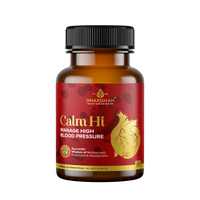Lower Your Blood Pressure with These Proven Strategies
Understanding High Blood Pressure
High blood pressure, also known as hypertension, is a common health condition affecting millions of people worldwide. It occurs when the force of blood against your artery walls is consistently too high. Over time, this can lead to serious health problems, including heart disease, stroke, and kidney damage.
Normal blood pressure is typically defined as less than 120/80 mmHg. Readings between 120/80 mmHg and 139/89 mmHg are considered prehypertension, while readings of 140/90 mmHg or higher indicate hypertension.
Understanding the factors that contribute to high blood pressure is crucial in developing effective strategies to lower it. These factors include:
-
Age
-
Family history
-
Obesity
-
Sedentary lifestyle
-
High salt intake
-
Excessive alcohol consumption
-
Stress
-
Certain medical conditions
Lifestyle Changes to Lower Blood Pressure
Making positive lifestyle changes is one of the most effective ways to lower high blood pressure naturally. Here are some key areas to focus on:
1. Maintain a Healthy Weight
Excess weight puts additional strain on your heart and blood vessels. Losing even a small amount of weight can significantly reduce your blood pressure. Aim for a body mass index (BMI) between 18.5 and 24.9.
2. Reduce Sodium Intake
High sodium intake is strongly linked to elevated blood pressure. The American Heart Association recommends limiting sodium to no more than 2,300 mg per day, with an ideal limit of 1,500 mg for most adults. Here are some tips to reduce your sodium intake:
-
Read food labels and choose low-sodium options
-
Cook meals at home using fresh ingredients
-
Avoid processed and packaged foods
-
Use herbs and spices instead of salt for flavoring
3. Limit Alcohol Consumption
Drinking too much alcohol can raise your blood pressure. If you choose to drink, do so in moderation. This means up to one drink per day for women and up to two drinks per day for men.
4. Quit Smoking
Smoking increases blood pressure and heart rate. Quitting smoking can help lower your blood pressure and reduce your risk of heart disease and other health problems.
Dietary Approaches to Reduce Hypertension
A healthy diet plays a crucial role in managing blood pressure. The DASH (Dietary Approaches to Stop Hypertension) eating plan is specifically designed to help lower blood pressure. Here are some key components of a blood pressure-friendly diet:
1. Increase Potassium Intake
Potassium helps balance the effects of sodium in your body. Foods high in potassium include:
-
Bananas
-
Sweet potatoes
-
Spinach
-
Beans
-
Avocados
2. Eat More Fruits and Vegetables
Aim for at least 5 servings of fruits and vegetables per day. These foods are rich in vitamins, minerals, and fiber, which can help lower blood pressure.
3. Choose Whole Grains
Whole grains are a good source of fiber and other nutrients that help regulate blood pressure. Replace refined grains with whole grain options like:
-
Brown rice
-
Quinoa
-
Whole wheat bread
-
Oatmeal
4. Include Lean Proteins
Choose lean protein sources such as:
-
Fish (especially fatty fish like salmon)
-
Skinless poultry
-
Legumes
-
Low-fat dairy products
5. Limit Saturated and Trans Fats
Reduce your intake of saturated fats found in red meat and full-fat dairy products. Avoid trans fats, which are often found in processed foods and baked goods.
Exercise and Physical Activity
Regular physical activity is essential for maintaining healthy blood pressure levels. Here are some guidelines for incorporating exercise into your routine:
1. Aerobic Exercise
Aim for at least 150 minutes of moderate-intensity aerobic exercise or 75 minutes of vigorous-intensity aerobic exercise per week. Activities may include:
-
Brisk walking
-
Jogging
-
Cycling
-
Swimming
2. Strength Training
Include strength training exercises at least two days per week. This can help build lean muscle mass and improve overall cardiovascular health.
3. Flexibility and Balance Exercises
Incorporate stretching and balance exercises to improve overall fitness and reduce the risk of injury.
4. Consistency is Key
Start slowly and gradually increase the duration and intensity of your workouts. Consistency is more important than intensity when it comes to long-term blood pressure management.
Stress Management Techniques
Chronic stress can contribute to high blood pressure. Implementing stress management techniques can help lower your blood pressure and improve overall well-being. Consider the following strategies:
1. Practice Mindfulness Meditation
Mindfulness meditation can help reduce stress and lower blood pressure. Start with just a few minutes a day and gradually increase the duration.
2. Try Deep Breathing Exercises
Deep breathing exercises can activate the body's relaxation response and help lower blood pressure. Try the 4-7-8 technique:
-
Inhale for 4 seconds
-
Hold your breath for 7 seconds
-
Exhale slowly for 8 seconds
-
Repeat the cycle 3-4 times
3. Engage in Yoga or Tai Chi
These mind-body practices combine physical movement with breath control and meditation, which can help reduce stress and lower blood pressure.
4. Prioritize Sleep
Aim for 7-9 hours of quality sleep each night. Poor sleep can contribute to high blood pressure and increased stress levels.
Natural Supplements and Herbs
Some natural supplements and herbs may help support healthy blood pressure levels. However, it's important to consult with a healthcare professional before starting any new supplement regimen, especially if you're taking medications. Some potentially beneficial supplements include:
-
Garlic
-
Magnesium
-
Coenzyme Q10
-
Fish oil
-
Hibiscus tea
The Role of Ayurveda in Blood Pressure Management
Ayurveda, an ancient Indian system of medicine, offers holistic approaches to managing blood pressure. Dharishah Ayurveda specializes in Ayurvedic treatments and products that may help support healthy blood pressure levels.
One such product is Calm Hi Tablets, which is formulated to help maintain healthy blood pressure. These tablets contain a blend of traditional Ayurvedic herbs known for their potential blood pressure-regulating properties.
Ayurvedic practices that may help lower blood pressure include:
-
Following a dosha-specific diet
-
Practicing yoga and meditation
-
Using herbal remedies under the guidance of an Ayurvedic practitioner
-
Incorporating stress-reducing practices like abhyanga (self-massage)
It's important to note that while Ayurvedic approaches can be beneficial, they should be used in conjunction with, not as a replacement for, conventional medical treatments for high blood pressure.
Monitoring and Tracking Your Progress
Regularly monitoring your blood pressure is crucial for managing hypertension effectively. Here are some tips for tracking your progress:
-
Invest in a home blood pressure monitor
-
Take readings at the same time each day
-
Keep a log of your readings
-
Share your results with your healthcare provider
Remember that blood pressure can fluctuate throughout the day, so don't be discouraged by occasional high readings. Focus on the overall trend of your measurements.
When to Seek Medical Help
While lifestyle changes and natural remedies can be effective in managing blood pressure, it's important to know when to seek medical help. Contact your healthcare provider if:
-
Your blood pressure readings consistently remain high despite lifestyle changes
-
You experience symptoms such as severe headaches, chest pain, or shortness of breath
-
You have a family history of heart disease or stroke
-
You have other underlying health conditions
Your doctor may recommend medication in addition to lifestyle changes to help manage your blood pressure effectively.
Conclusion: Taking Control of Your Blood Pressure
Lowering high blood pressure is a journey that requires patience, commitment, and a multi-faceted approach. By implementing the strategies outlined in this guide, you can take significant steps towards improving your blood pressure and overall health.
Remember to:
-
Make sustainable lifestyle changes
-
Follow a heart-healthy diet
-
Stay physically active
-
Manage stress effectively
-
Consider natural supplements and Ayurvedic approaches
-
Monitor your progress regularly
-
Consult with healthcare professionals as needed
By taking control of your blood pressure, you're investing in your long-term health and well-being. Start small, be consistent, and celebrate your progress along the way. With dedication and the right strategies, you can successfully lower your blood pressure and reduce your risk of associated health complications.












